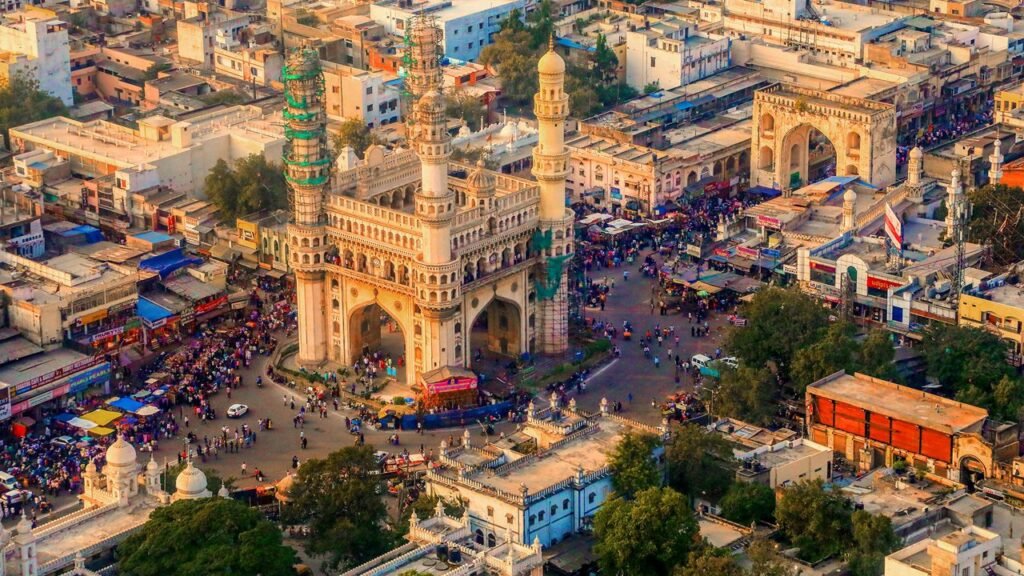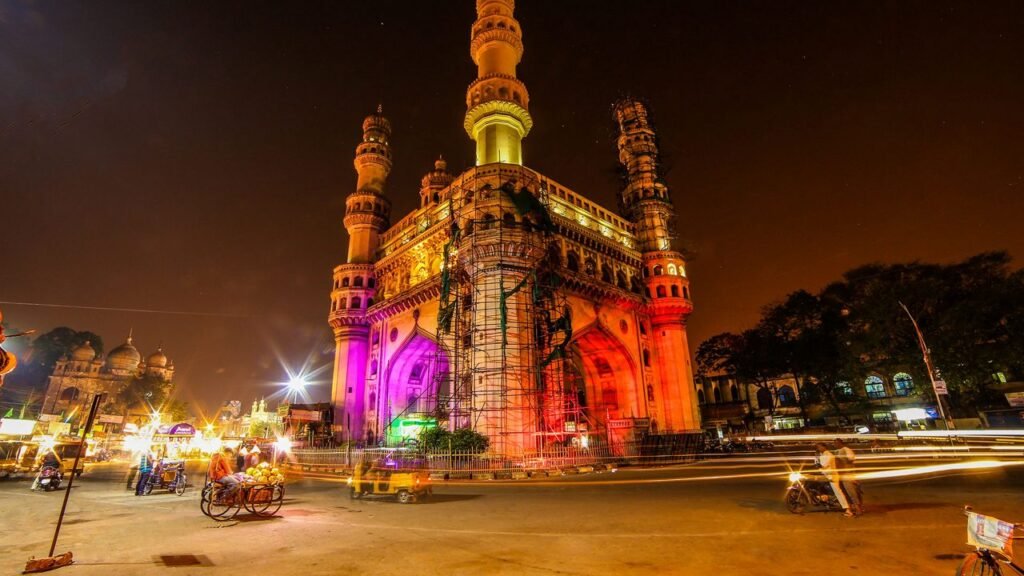Charminar is not just an iconic monument; it is a living symbol of Hyderabad’s vibrant history, enduring culture, and bustling modern life. Rising gracefully with its four majestic minarets, this architectural marvel invites travelers, historians, shoppers, and food lovers to experience the essence of India’s Deccan region.
Key Details:
Notes on Visiting Time and Cost of Travel
- Nearby Visits: Travelers can walk to key attractions and markets around Charminar, spending extra on entry to palaces, museums, or parks.
- Visiting Time: Best to visit in the morning for peace and less crowd, or evenings for the lit-up view. Fridays and festival times are most crowded.
- Entry Ticket: Can be purchased at the counter; keep valid ID.
- Travel Costs: Local public transport is cost-efficient but taxis/ride-shares provide greater comfort and direct access.
History of the Charminar
Charminar was constructed in 1591 by Sultan Muhammad Quli Qutb Shah, the fifth ruler of the Qutb Shahi dynasty, making it over four centuries old. Legend holds that the Sultan built this structure to commemorate the eradication of a catastrophic plague which had ravaged Hyderabad, or to celebrate the start of the second Islamic millennium.
Perched at the intersection of ancient trade routes, Charminar became the focal point of the newly established city of Hyderabad. Its construction marked the fusion of Indo-Islamic and Persian architectural influences, with possible ties to both spiritual fulfillment and civic planning. The city itself grew outward from the monument, symbolizing a new era of hope and resilience.
The Charminar has witnessed centuries of historical events, surviving the rule of Mughal emperors, Nizams, and the changing tides of history. It has been lovingly maintained and periodically restored, with features such as brilliant clocks added in the late 19th century to each minaret. After more than 430 years, Charminar stands strong as a beacon of Hyderabad’s identity.
Architectural Splendor & Design
Charminar is a masterpiece of Indo-Islamic architecture, laced with rich Persian influences. The monument rises 48.7 meters (about 160 feet) above ground and is built with granite, limestone, and pulverized marble, giving it both grandeur and longevity.
Key architectural highlights:
- Square structure with four grand arches, each facing a cardinal direction
- Four soaring minarets (hence “Charminar”, ‘Char’ = four, ‘Minar’ = minarets in Urdu)
- 149 spiral steps within the minarets leading to an upper-level mosque
- Intricate stucco ornamentation, beautiful balconies, and Indo-Persian motifs
- Clocks added on each minaret in 1889
At the top is a mosque, making Charminar both a spiritual and civic landmark. The design blends Islamic arches, domes, and calligraphic detail with subtle elements borrowed from local Hindu craftsmanship.
Charminar’s Cultural and Religious Significance
Charminar is woven into the very fabric of Hyderabad’s multi-religious culture and daily life. It has long served as a gathering place for prayer, celebration, and trade. During major Islamic festivals like Eid-ul-Fitr and Eid-ul-Adha, thousands gather in and around Charminar, filling the area with festive energy.
The site is a living tribute to Hyderabad’s syncretic heritage, celebrating both its Islamic and local Deccan roots. The prayers offered here and the nearby Mecca Masjid symbolize a communal hope for prosperity and health. Poetic legends, such as the Sultan’s wish for the city to be as abundant with people as the river with fish, are an enduring part of Charminar’s narrative.

Charminar as a Tourist Destination
Why Visit Charminar?
Charminar is one of India’s most visited heritage monuments. It’s located in the pulsating heart of Hyderabad, surrounded by vibrant bazaars and exquisite street food. A trip to Hyderabad would be incomplete without experiencing the bustling Laad Bazaar (famous for bangles), tasting local delicacies like biryani, and soaking in centuries-old traditions under the Charminar’s arches.
Things to Do:
- Explore Charminar’s intricate architecture, including its arches, minarets, and calligraphy
- Climb up the winding staircases for panoramic views of the Old City
- Shop for bangles, pearls, and handicrafts in Laad Bazaar
- Experience the culture through local cuisine, Hyderabadi biryani, Irani chai, kebabs, and sweets
- Visit nearby heritage sites such as Mecca Masjid, Chowmahalla Palace, and Salar Jung Museum
Visitor Information:
- Visiting hours: 9:00 AM – 5:30 PM, preferably from October to February for the best weather
- Entry Fee: ₹20 for Indians, ₹150 for foreigners as of 2025
- Duration: 3–4 hours for a complete experience
- Restricted items: Weapons, inflammables, sharp objects
Routes, Location & Travel Tips
Location: Charminar, Ghansi Bazaar, Hyderabad, Telangana 500002
Distances from Key Points:
- Hyderabad Airport: 20 km (approx. 40–50 minutes by car)
- Hyderabad Railway Station: 5 km (approx. 15–20 minutes by car)
- Hitech City: 17 km (approx. 45–50 minutes by car)
How to Reach:
- By taxi/car: Easily accessible from all parts of Hyderabad, book online cabs or hire a local taxi
- By metro: Nearest station is MGBS (2 km away), well connected by Hyderabad Metro Rail
- By bus: Regular TSRTC buses connect major city points; many local buses (Nos. 2c, 8a, 9m, etc.) directly serve the area
Local Tips:
- Arrive early to avoid crowds and midday heat
- Evenings are magical when the monument is illuminated
- Dress modestly as there is a mosque and religious activity
- Beware of busy traffic and parking constraints, public transport may be easier
Charminar’s Economic Impact & Tourism Revenue
Charminar is not just a tourist attraction but a major economic engine for Hyderabad’s old city. With nearly 1.4 million visitors annually as of 2024, the site generates significant revenue through entry fees, boosting surrounding markets, local crafts, and food tourism.
Tourism Revenue Snapshot:
- Average annual visitors: About 1.4 million
- Entry fee (2025): ₹20 (Indian), ₹150 (foreigner)
- Yearly revenue (recent years): Approx. ₹2.7 crore
- Additional indirect revenue from Laad Bazaar, Mecca Masjid, and other nearby attractions is substantial but unquantified
Complaints about congestion and limited amenities have limited visitor growth compared to other monuments, but initiatives to pedestrianize the area are improving visitor comfort and local business opportunities.
Recent News: Closures and Current Developments
In September 2025, the Archaeological Survey of India (ASI) announced that Charminar would remain closed to visitors on September 6 due to Ganesha idol immersion ceremonies, highlighting both its continuing relevance to city life and sensitivity to local customs. Such announcements are crucial for travelers planning a trip and showcase the monument’s enduring role in contemporary Hyderabad.
FAQs About Charminar
Why is Charminar famous?
Charminar is revered both for its stunning architecture, a fusion of Indo-Islamic and Persian styles, and for its historical role as the birthplace and main landmark of Hyderabad. Its vibrant surroundings, rich history, and cultural significance make it one of India’s most iconic monuments.
What is the story behind Charminar’s construction?
It was built in 1591 by Sultan Muhammad Quli Qutb Shah, either to commemorate the end of a deadly plague or to mark the start of the second Islamic millennium.
Where is Charminar located, and how do you reach it?
Charminar is located in the Old City of Hyderabad at Ghansi Bazaar, easily accessible by road, metro (nearest station: MGBS), and city buses.
What are the entry fees and timings for Charminar?
Entry fee as of 2025: ₹20 (Indians), ₹150 (foreign nationals). It is open from 9:00 AM to 5:30 PM, with the best months to visit being October to February.
What can travelers do nearby?
Popular activities include shopping at Laad Bazaar, tasting Hyderabadi street food, and visiting Mecca Masjid, Chowmahalla Palace, and Salar Jung Museum.
How does Charminar contribute to Hyderabad’s economy?
Through entry fees, bustling bazaars, and heritage tourism, Charminar generates direct and indirect revenue, supporting local artisans, the hospitality industry, and the city’s vibrant old markets.
Is there a mosque inside Charminar?
Yes, the upper floor of Charminar houses a mosque, making it not just a historical but also a spiritual landmark.
Charminar’s Enduring Legacy
Charminar is not just a monument, it is a living storybook of Hyderabad’s resilience, artistry, faith, and cosmopolitan ethos. Whether marveled at by historians, prayed in by faithful, or cherished by travelers, it continues to inspire generations and shape the city’s destiny.
